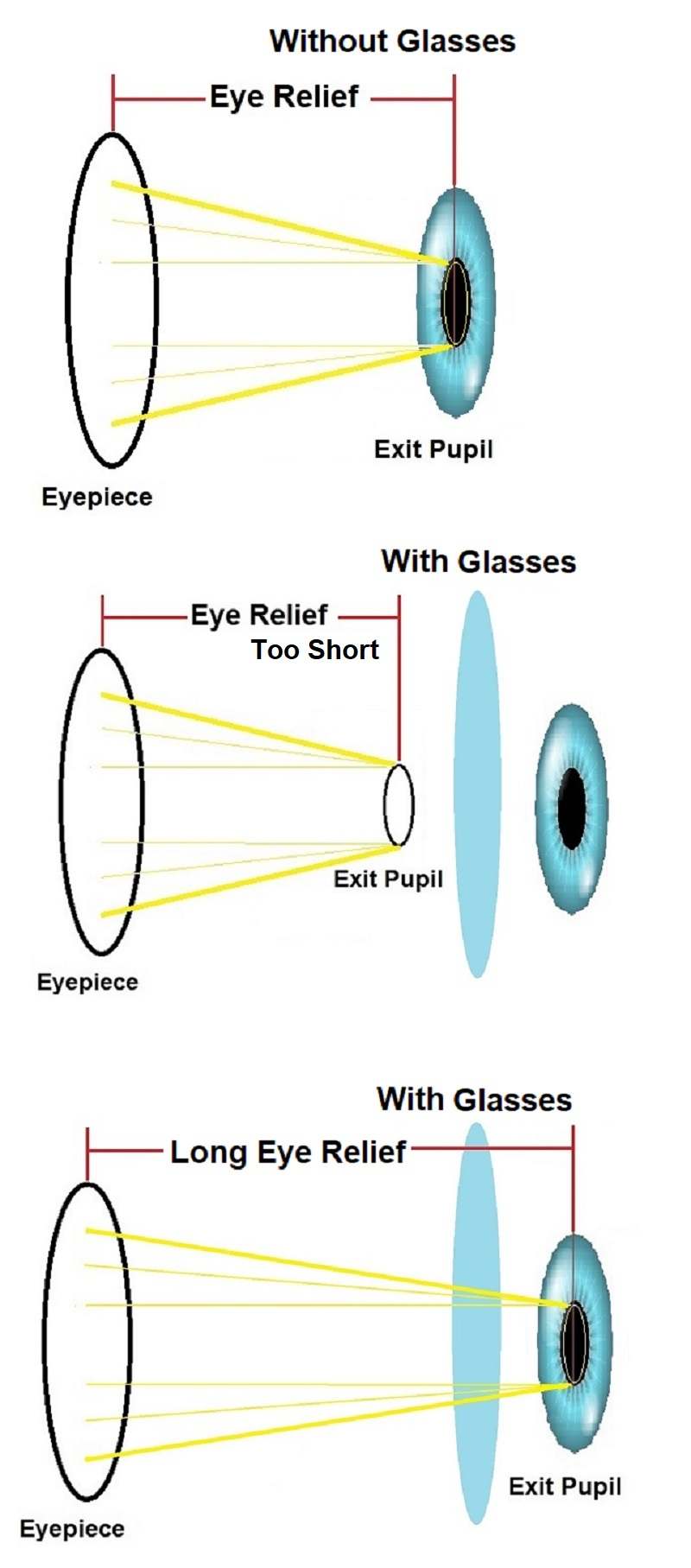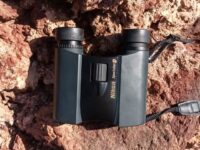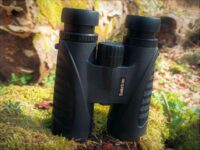Many people rely on glasses to be able to see normally. Those who suffer from severe ametropia usually have to wear their eyeglasses when using an optical instrument too. This can often lead to problems when using binoculars if you wear glasses.
Using Binoculars With Glasses
To see the projected image in its entirety when using binoculars, the eye must be placed a certain distance from the eyepiece.
This distance is the “eye relief“, the place where the exit pupil of the binoculars meets the entry pupil of the eye. Only then will a complete image without shadows or constrictions be seen.
Because the eyeglasses create an additional distance between the eye and the eyepiece, the eye relief may be too short, i.e. the eyes of the observer are too far from the binoculars.

Binoculars for people with glasses
Binoculars usually have diopter compensation, so one eyepiece can be finely focused, to compensate for the eye’s different strength. The dioptric compensation for standard binoculars is usually around +/- 2 diopter, give or take.
With only weak ametropia, where only the refractive power of the eye needs to be corrected, this diopter compensation may be is sufficient to compensate for the visual defect and you can use the binoculars without wearing your glasses.
Some premium binoculars and high-end models come with a diopter compensation of up to +/- 8 diopters.
However, people with more complex restrictions, such as B. severe myopia, astigmatism, or farsightedness are dependent on special binoculars that are suitable for use with glasses. These Binoculars for people with glasses are characterized by long eye relief.
Binoculars for Eyeglass Wearers
Binoculars that are suitable for eyeglass wearers are fitted with special eyepieces that set the exit pupil further back than conventional lenses, thus the eye relief is longer.
This ensures that the wearer of glasses can see the entire field of view without annoying peripheral phenomena. This would be noticeable in black, round shadows on the edge of the image or in kidney-shaped shadows.
Special eyepieces
Binocular designers have also developed special eyepieces for those who wear glasses. With these, the exit pupil of the binoculars is set to further back so that you can see the entire field of view even with the glasses on.
These special eyepieces usually consist of complex lens systems with numerous lenses (often 6 to 8 lenses). More lenses come at the cost of transmission, so it is necessary to use higher quality glass with complex coatings.
Because of this special design feature, these binoculars with long eye relief, are significantly more expensive, but also much more comfortable to be used by people who wear glasses.

Binoculars With Long Eye Relief
To use binoculars comfortably while wearing the glasses, the eye relief should be between 16 and 20 mm.
Nowadays, most binoculars, if you are not buying from the budget segment, have an eye relief that is long enough so that people with eye-glasses can use these binoculars. Make sure to read the product specifications carefully.
Eyecups especially for Eyeglass Wearers
Many binoculars are equipped with eyecups. They are designed to prevent glare from disturbing stray light and bring the observer’s eye into the correct distance from the eyepiece so that the image of its entirety can be seen.
Eyecups are either made of plastic or rubber and must be retractable or need to be folded down so the eyeglass wearer can bring its eye near enough to the binoculars. Binoculars with non-adjustable eyecups may not be suitable for eyeglass wearers because of the above reasons.
What About wearing Contact Lenses
Wearers of contact lenses don’t have to worry about special binoculars. Just like normal-sighted people, contact lens wearers can use binoculars without problems.
For someone who is used to wearing contact lenses, there may soon be another option. Researchers have developed contact lenses that can zoom in on objects for a better view.
What are the best binoculars if you wear glasses?
When choosing binoculars for people with glasses, you should make sure that the eye relief is between 16 to 20 mm. This should allow trouble-free use for most users.
You should also pay attention to the eyecups. These must be adjustable, ideally, they are of soft plastic or rubber and can be retracted or folded down.
Binoculars with low magnification (i.e. 8x) usually have a larger eye relief and also a larger exit pupil and allow the full field of view to be seen even with glasses.
The higher the magnification of the binoculars, the more complex and expensive the lens system must be so that the wearer of the glasses can use binoculars.



